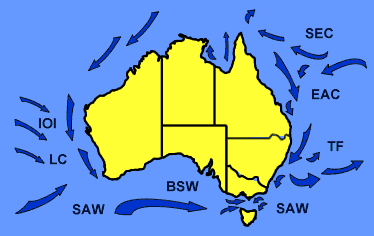|
|
Water Currents
Environmental Factors
For a population of organisms to be able to continue to exist on any given shore, there must be an overall circular pattern to the ocean currents over time. If the organism's offspring are tiny plankton, it is necessary for them to be delivered back to a particular shore. If not, the species must become extinct on that shore.
Around Australia there are a number of major currents which influence coastal waters and the animal and algae plankton that are dependent upon them for transportation to a suitable habitat for growth and reproduction.
Some of these currents are:
|
SEC South Equatorial Current EAC East Australian Current TF Tasman Front SAW Subantarctic Waters (= west wind drift) |
BSW Bass Strait Waters LC Leeuwin Current IOI Indian Ocean Inflow |

Map from
"Coastal and Marine Ecology of Temperate Australia"
edited by A.J. Underwood & M.G. Chapman.
UNSW Press, Chap.3 Planktonic Processes p.35
References
Bennett, I. (1987) W. J. Dakin's classic study: Australian Seashores. p. 3-12, Angus & Robertson, Sydney.
Davey, K. (1998) A Photographic Guide to Seashore Life of Australia. p.8, New Holland, Sydney.
Environmental
Factors
Latitude
Currents
Wind Effects
Wave Strength
Tidal Effects
Desiccation
Substrate
Turbidity
Salinity
Home
Page
Taxonomy
Biogeography
Rocky Shores
Tidal Levels
Intertidal Zonation
Environmental Factors
Biological
Factors
Feeding Relationships
Activities
Glossary
References
 Life
on Australian Seashores
Life
on Australian Seashores
by Keith Davey (C) 2000
Learning Consultant
- Media
The University of Newcastle
email at australian_seashores@hotmail.com
Scientific Consultant: Phil
Colman
site created 01.01.98 : updated 01.04.2000
